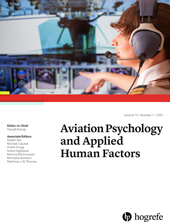Evaluation of a Tunnel-in-the-Sky Head-Up Display Design for Curved Approaches Using Eye-Tracking
Abstract
Abstract. Head-up displays (HUD) assist pilots, especially in the approach and landing phase. In this paper we compared pilots’ eye-tracking behavior between a pathway-in-the-sky layout versus the more conventional two-dimensional symbology in an HUD in a fixed-based cockpit simulator. In particular, we wanted to assess how visual attention was distributed within each layout (tunnel and standard). Performance and eye-tracking data were recorded, as well as workload and situation awareness measures. Results showed that the tunnel-in-the-sky symbology provided a very high tracking performance with low perceived workload and high perceived situational awareness. The analysis of the eye-tracking data revealed possible attentional tunneling with the tunnel-in-the-sky symbology and large differences between the displays in the distribution of visual attention.
References
. (2017). A318/A319/A320/A321 Flight Crew Techniques Manual. Reference: LFO A318/A319/A320/A321 FLEET FCTM. Leiden: Airbus
(1997). Visual scanning and pilot expertise: the role of attentional flexibility and mental model development. Aviation, Space, and Environmental Medicine, 68, 569–579.
(2000).
Development of highway-in-the-sky displays for flight-path guidance: History, performance results, guidelines . In HFESEd., Proceedings of the IEA 2000/HFES 2000 Congress (pp. 21–24). San Diego, CA: Human Factors and Ergonomics Society.(2001). A comparison of pilot navigation performance using conventional instrumentation, head-down, and head-up highway-in-the-sky primary flight displays. Proceedings of the Human Factors and Ergonomics Society 46th Annual Meeting, 45, 16–20. https://doi.org/10.1177/154193120104500203
(2001). Pathway HUDs: Are they viable? Human Factors, 43(2), 173–193. https://doi.org/10.1518/001872001775900841
(1980). Cognitive issues in head-up displays (NASA TP-1711). Washington, DC: NASA.
(2013). Cockpit visualization of curved approaches based on GBAS. Navigation, 60(4), 305–317.
(1996). Improved tunnel display for curved trajectory following: Experimental evaluation. Journal of Guidance, Control and Dynamics, 19(2), 378–384.
(1980). Evaluation of a computer-generated perspective tunnel display for flight-path following (NASA Technical Paper No. TP-1736). Washington, DC: NASA.
(1981). Experimental evaluation of a perspective tunnel display for three-dimensional helicopter approaches. Journal of Guidance, Control and Dynamics, 4(5), 623–631.
(1988).
Development of NASA-TLX (Task Load Index): Results of empirical and theoretical research . In P. A. HancockN. MeshkatiEds., Human Mental Workload (pp. 139–183). Amsterdam, The Netherlands: North Holland Press.(1993). Two-and three-dimensional displays for aviation: A theoretical and empirical comparison. The International Journal of Aviation Psychology, 3(2), 87–109. https://doi.org/10.1207/s15327108ijap0302_1
. (2013). ICAO Doc 9613 AN/937: Performance-based navigation (PBN) manual. Montréal, Canada: ICAO.
(1998).
Definition and computation of oculomotor measures in the study of cognitive processes . In G. UnderwoodEd., Eye guidance in reading, driving and scene perception (pp. 29–53). Oxford, UK: Elsevier.(2000). Comparison of pilots’ situational awareness while monitoring autoland approaches using conventional and advanced flight display formats (NASA/TP-2000–210284). Hampton, VA: Langley Research Center
(1997). Superimposition, symbology, visual attention, and the head-up display. Human Factors, 39(4), 581–601. https://doi.org/10.1518/001872097778667933
(2002). Delft aerospace tunnel-in-the-sky flight tests. Paper presented at the AIAA Guidance, Navigation & Control Conference, Monterey, CA.
(1994). Spatial awareness comparisons between large-screen, integrated pictorial displays and conventional EFIS displays during simulated landing approaches (Vol. 3467). Hampton, VA: National Aeronautics and Space Administration, Langley Research Center.
(2018). Eye-tracking measures in aviation: A selective literature review. The International Journal of Aerospace Psychology, 28(3–4), 98–112. https://doi.org/10.1080/24721840.2018.1514978
(1995). A comparison of two head up display formats used to fly curved instrument approaches. Proceedings of the Human Factors and Ergonomics Society Annual Meeting, 39(1), 1–4.
(2001). Parametersystematik der Augen-und Blickbewegungen für arbeitswissenschaftliche Untersuchungen
[Parameter classification of eye and gaze movement in ergonomic studies] . Germany: Shaker.(2007). Pilots’ monitoring strategies and performance on automated flight decks: An empirical study combining behavioral and eye-tracking data. Human Factors, 49, 347–357. https://doi.org/10.1518/001872007X196685
(2002). Effects of a virtual air speed error indicator on guidance accuracy and eye movement control during simulated flight. Proceedings of the 46th Human Factors and Ergonomics Society Annual Meeting, 47, 1594–1598.
(2014). Evaluation of satellite based instrument approaches with curved tracks. Diploma Thesis, Technical University Dresden, Department of Aircraft Technology, Institute of Mechanical Engineering, DLR Report 112-2014/41.
(1989).
Evaluation of the situational awareness rating technique (SART) as a tool for aircrew systems design . In AGARDEd., Proceedings of the AGARD AMP Symposium on Situational Awareness in Aerospace Operations, CP478 (pp. 72–79). Seuilly-sur Seine, France: NATO AGARD.(2002).
Effects of primary flight symbology on workload and situation awareness in a head-up synthetic vision display . In IEEEEd., Proceedings of the 21st Digital Avionics Systems Conference (2) (pp. 11C5–1). Piscataway, IL: IEEE.(2002).
On-road driver eye movement tracking using head-mounted devices . In ACMEd., Proceedings of the 2002 Symposium on Eye Tracking Research & Applications (pp. 61–68). New York, NY: ACM.(1998). Head-up displays: Effects of clutter, display intensity, and display location on pilot performance. The International Journal of Aviation Psychology, 8(4), 377–403. https://doi.org/10.1207/s15327108ijap0804_4
(2000). Designing head-up displays (HUDs) to support flight path guidance while minimizing effects of cognitive tunneling. Proceedings of the Human Factors and Ergonomics Society Annual Meeting, 44(13), 45–48.
(1989). Ergonomic design for perspective flight-path displays. IEEE Control Systems Magazine, 9(4), 3–8. https://doi.org/10.1109/37.24831
(2002). Impact of aviation highway-in-the-sky displays on pilot situation awareness. Human Factors, 44(1), 18–27. https://doi.org/10.1518/0018720024494801
(1997). Eye movements reveal the spatiotemporal dynamics of visual search. Psychological Science, 8(6), 448–453. https://doi.org/10.1111/j.1467-9280.1997.tb00459.x
(2016). Gaze behavior and visual attention: A review of eye tracking studies in aviation. The International Journal of Aviation Psychology, 26(3–4), 75–104. https://doi.org/10.1080/10508414.2017.1313096



